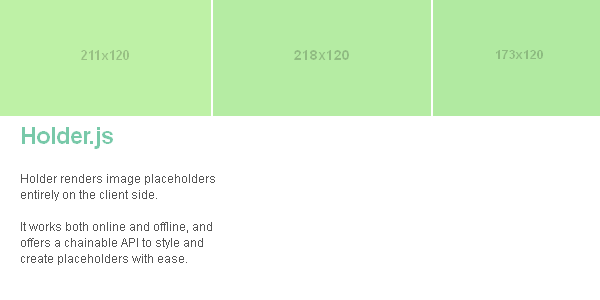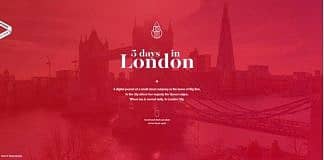Holder is a client-side image placeholder library that uses canvas and the data URI scheme to render placeholders entirely in browser.
It works both online and offline, and offers a chainable API to style and create placeholders with ease.
How to use it
Include holder.js in your HTML. Holder will process all images with a specific src attribute, like this:
<img decoding="async" src="holder.js/200x300">The above will render as a placeholder 200 pixels wide and 300 pixels tall.
To avoid console 404 errors, you can use data-src instead of src.
Holder also includes support for themes, to help placeholders blend in with your layout. There are 3 default themes: gray, industrial, and social. You can use them like this:
<img decoding="async" src="holder.js/200x300/industrial">Customizing themes
Themes have 3 properties: foreground, background, and size. The size property specifies the minimum font size for the theme. You can create a sample theme like this:
Holder.add_theme("dark", {background:"#000", foreground:"#aaa", size:11})Using custom themes
There are two ways to use custom themes with Holder:
- Include theme at runtime to render placeholders already using the theme name
- theme at any point and re-render placeholders that are using the theme name
The first approach is the easiest. After you include holder.js, add a script tag that adds the theme you want.
The second approach requires that you call run after you add the theme, like this:
Holder.add_theme("bright", {background:"white", foreground:"gray", size:12}).run()Using custom themes and domain on specific images
You can use Holder in different areas on different images with custom themes:
<img data-src="example.com/100x100/simple" id="new">
Holder.run({
domain: "example.com",
themes: {
"simple":{
background:"#fff",
foreground:"#000",
size:12
}},
images: "#new"
})Using custom colors on specific images
You don't have to create a new theme just to use custom colors. Custom colors can be specified in the background:foreground format using hex notation, like this:
<img data-src="holder.js/100x200/#000:#fff">The above will render a placeholder with a black background and white text.
Using partially custom settings
Holder extends its default settings with the settings you provide, so you only have to include those settings you want changed. For example, you can run Holder on a specific domain like this:
Holder.run({domain:"example.com"})Using custom settings on load
You can prevent Holder from running its default configuration by executing Holder.run with your custom settings right after including holder.js. However, you'll have to execute Holder.run again to render any placeholders that use the default configuration.
Inserting an image with optional custom theme
You can add a placeholder programmatically by chaining Holder calls:
Holder.add_theme("new",{foreground:"#ccc", background:"#000", size:10}).add_image("holder.js/200x100/new", "body").run()The first argument in add_image is the src attribute, and the second is a CSS selector of the parent element.
Browser support
- Chrome 1+
- Firefox 3+
- Safari 4+
- Internet Explorer 9+, with fallback for IE6-8
- Android 1+











